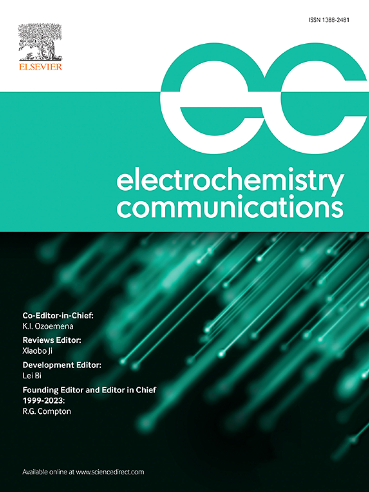Homogeneous electrochemical detection of carcinoembryonic antigen based on target-controlled catalytical reaction of platinum/UiO-66 MOFs nanozyme integrated with aptamer
IF 4.2
3区 工程技术
Q2 ELECTROCHEMISTRY
引用次数: 0
Abstract
In this work, a novel homogeneous electrochemical (HEC) sensing strategy was developed for carcinoembryonic antigen (CEA) detection, addressing limitations of traditional electrochemical platforms that necessitate complex electrode modifications and receptor immobilization protocols. This approach integrates platinum nanoparticle-loaded UiO-66 metal-organic frameworks (Pt/UiO) as an oxidase-like nanozyme with CEA-specific aptamer (Apt) as recognition element, establishing a target-responsive catalytic mechanism. In solution-phase operation, the Pt/UiO nanozyme facilitates the oxidation of 1,2-diaminobenzene into electroactive diaminophenazine (DAP), generating measurable reduction current at unmodified electrode. Apt adsorption onto Pt/UiO surfaces effectively inhibits this enzymatic activity through steric hindrance, resulting in current suppression proportional to Apt coverage. The presence of CEA induces specific Apt-CEA binding, resulting Apt away from the nanozyme surface and restoring catalytic activity in a concentration-dependent manner. Optimization of experimental parameters (e.g., nanozyme concentration, incubation time) enabled the sensor to achieve a detection limit of 3 pg mL−1 with a linear range spanning 0.01–11 ng mL−1, demonstrating potential for point-of-care applications in tumor biomarker analysis.
基于铂/UiO-66纳米酶与适体整合的靶控催化反应的癌胚抗原均相电化学检测
在这项工作中,开发了一种用于癌胚抗原(CEA)检测的新型均相电化学(HEC)传感策略,解决了传统电化学平台需要复杂电极修饰和受体固定方案的局限性。该方法将负载铂纳米粒子的UiO-66金属有机框架(Pt/UiO)作为类氧化酶纳米酶,以cea特异性适配体(Apt)作为识别元件,建立靶响应催化机制。在液相操作中,Pt/UiO纳米酶促进1,2-二氨基苯氧化成电活性二氨基苯(DAP),在未修饰的电极上产生可测量的还原电流。Apt在Pt/UiO表面的吸附通过位阻有效地抑制了这种酶的活性,导致电流抑制与Apt覆盖成正比。CEA的存在诱导特异性的Apt-CEA结合,导致Apt远离纳米酶表面,并以浓度依赖的方式恢复催化活性。优化实验参数(例如,纳米酶浓度,孵育时间)使传感器达到3 pg mL - 1的检测限,线性范围为0.01-11 ng mL - 1,显示了在肿瘤生物标志物分析中的即时应用潜力。
本文章由计算机程序翻译,如有差异,请以英文原文为准。
求助全文
约1分钟内获得全文
求助全文
来源期刊

Electrochemistry Communications
工程技术-电化学
CiteScore
8.50
自引率
3.70%
发文量
160
审稿时长
1.2 months
期刊介绍:
Electrochemistry Communications is an open access journal providing fast dissemination of short communications, full communications and mini reviews covering the whole field of electrochemistry which merit urgent publication. Short communications are limited to a maximum of 20,000 characters (including spaces) while full communications and mini reviews are limited to 25,000 characters (including spaces). Supplementary information is permitted for full communications and mini reviews but not for short communications. We aim to be the fastest journal in electrochemistry for these types of papers.
 求助内容:
求助内容: 应助结果提醒方式:
应助结果提醒方式:


